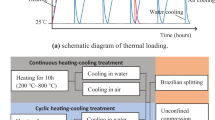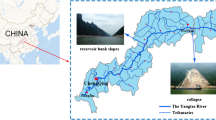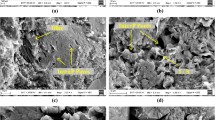Abstract
The nuclear magnetic resonance (NMR), ultrasonic testing, and triaxial compression tests were employed to investigate the deterioration laws of multiple physical and mechanical properties of sandstone under different pore water pressure cycles, and Micro- and Meso- deterioration mechanisms were analyzed via scanning electron microscopy (SEM). The critical stresses exhibited different variation trends concerning the cycling pore water pressure, which reflecting the difference in damage sensitivity to critical stresses. Observing the transverse relaxation time (T2) spectrum areas and SEM images, the number of internal pores and the crack size developed with the increase of pore water pressure cycles. Furthermore, the NMR images indicated that the sandstone pores under cycling pore water pressure gradually expanded from the bottom action end to the entire sample. The wave velocity of sample was linearly negatively correlated with the number of pore water pressure cycles and increasing porosity. The micro- and mesoscopic deterioration mainly resulted from the coupling hydraulic-mechanical effect, leading to the porosity increase and an increase in pore water content at the micro-level, which in turn resulted in the deterioration of the physical and mechanical properties of sandstone at the macro level. Damage characterized by the strength, deformation, acoustic parameters, and porosity indicating that the cycling pore water pressure have a cumulative damage effect on sandstone. However, the sandstone in the same damage state has a more significant effect on the deformation than the strength. The results can be adopted as a reference for the safety and security of reservoir slope.




























Similar content being viewed by others
Data availability statement
Some or all data, models, or code that support the findings of this study areavailable from the corresponding author upon reasonable request.
References
Adebayo AR, Bageri BS, Al Jaberi J et al (2020) A calibration method for estimating mudcake thickness and porosity using NMR data. J Petrol Sci Eng 195:107582
Bao Y, Gao P, He X (2015) The water-level fluctuation zone of Three Gorges Reservoir—A unique geomorphological unit. Earth-Sci Rev 150:14–24
Cai M, Kaiser PK, Tasaka Y et al (2004) Generalized crack initiation and crack damage stress thresholds of brittle rock masses near underground excavations. Int J Rock Mech Min 41(5):833–847
Coombes MA, Naylor LA (2012) Rock warming and drying under simulated intertidal conditions, part II: weathering and biological influences on evaporative cooling and near-surface micro-climatic conditions as an example of biogeomorphic ecosystem engineering. Earth Surf Proc Land 37(1):100–118
Deng HF, Zhi YY, Duan LL et al (2019) Mechanical properties of sandstone and damage evolution of microstructure under water-rock interaction. Rock Soil Mech 40(9):3447–3456 (in Chinese)
Eberhardt E, Stead D, Stimpson B (1999) Quantifying progressive pre-peak brittle fracture damage in rock during uniaxial compression. Int J Rock Mech Min 36(3):361–380
Everitt RA, Lajtai EZ (2004) The influence of rock fabric on excavation damage in the Lac du Bonnett granite. Int J Rock Mech Min 41(8):1277–1303
Finn CA, Deszcz-Pan M, Ball JL et al (2018) Three-dimensional geophysical mapping of shallow water saturated altered rocks at Mount Baker, Washington: Implications for slope stability. J Volcanol Geoth Res 357:261–275
Gao F, Wang Q, Deng H et al (2017) Coupled effects of chemical environments and freeze–thaw cycles on damage characteristics of red sandstone. B Eng Geol Environ 76(4):1481–1490
Huang D, Gu D, Yang C et al (2016) Investigation on mechanical behaviors of sandstone with two preexisting flaws under triaxial compression. Rock Mech Rock Eng 49(2):375–399
Huang S, Liu Q, Liu Y et al (2018) Freezing strain model for estimating the unfrozen water content of saturated rock under low temperature. Int J Geomech 18(2):04017137
Huang S, Lu Z, Ye Z et al (2020) An elastoplastic model of frost deformation for the porous rock under freeze-thaw. Eng Geol 278:105820
Huang S, He Y, Liu X et al (2021) Experimental investigation of the influence of dry-wet, freeze-thaw and water immersion treatments on the mechanical strength of the clay-bearing green sandstone. Int J Rock Mech Min 138:104613
Jia H, Zi F, Yang G et al (2020) Influence of pore water (ice) content on the strength and deformability of frozen argillaceous siltstone. Rock Mech Rock Eng 53(2):967-974(2)
Kachanov LM (1958) Time of the rupture process under creep conditions, Izy Akad. Nank SSR Otd Tech Nauk 8:26–31
Kawamoto T, Ichikawa Y, Kyoya T (1988) Deformation and fracturing behaviour of discontinuous rock mass and damage mechanics theory. Int J Numer Anal Met 12(1):1–30
Kim JS, Lee KS, Cho WJ et al (2015) A comparative evaluation of stress–strain and acoustic emission methods for quantitative damage assessments of brittle rock. Rock Mech Rock Eng 48(2):495–508
Kleinberg RL, Kenyon WE, Mitra PP (1994) Mechanism of NMR relaxation of fluids in rock. J Magn Reson 108(2):206–214
Li XG, Yao YS, Zeng ZX et al (2006) Analysis of the formation system of the present tectonic stress field in the head area of the three gorges reservoir. J Geomech 02:174–181 (in Chinese)
Li Y, Huang D, Li X (2014) Strain rate dependency of coarse crystal marble under uniaxial compression: strength, deformation and strain energy. Rock Mech Rock Eng 47(4):1153–1164
Li N, Zhang X, Wang D et al (2017) Experimental study on variation of P-wave velocity and waveform characteristics during the whole process of water absorption of coal samples. Chin J Rock Mech Eng 36(8):1921–1929 (in Chinese)
Li J, Huang W, Lu S et al (2018) Nuclear magnetic resonance T1–T2 map division method for hydrogen-bearing components in continental shale. Energ Fuel 32(9):9043–9054
Li J, Lu S, Chen G et al (2019) A new method for measuring shale porosity with low-field nuclear magnetic resonance considering non-fluid signals. Mar Petrol Geol 102:535–543
Li F, You S, Ji H et al (2020) Strength and energy exchange of deep sandstone under high hydraulic conditions. J Cent South Univ 27(10):3053–3062
Liu B, Yang H, Karekal S (2020) Effect of water content on argillization of mudstone during the tunnelling process. Rock Mech Rock Eng 53(2):799–813
Luo Z, Li J, Wang L et al (2019) Study on the creep characteristics of sandstone under coupled stress-water pressure. Period Polytech-Civ 63(4):1038
Ma L, Wang M, Zhang N et al (2017) A variable-parameter creep damage model incorporating the effects of loading frequency for rock salt and its application in a bedded storage cavern. Rock Mech Rock Eng 50(9):2495–2509
Ma L, Wu J, Wang M et al (2020) Dynamic compressive properties of dry and saturated coral rocks at high strain rates. Eng Geol 272:105615
Porfido C, Rizzo RE, Healy D et al (2021) Investigating the evolution of fractures in clay–based ceramics during repeated freeze-thawing cycles using X-ray micro-computed tomography and image analysis. Mater Characte 177:111185
Prick A (1995) Dilatometrical behaviour of porous calcareous rock samples subjected to freeze-thaw cycles. CATENA 25(1–4):7–20
Qin Z, Fu H, Chen X (2019) A study on altered granite meso-damage mechanisms due to water invasion-water loss cycles. Environ Earth Sci 78(14):1–10
Song Y, Zhang L, Ren J et al (2019) Study on damage characteristics of weak cementation sandstone under drying-wetting cycles based on nuclear magnetic resonance technique. Chin J Rock Mech Eng 38(4):825–831 (in Chinese)
Su K, Ghoreychi M, Chanchole S (2000) Experimental study of damage in granite. Geotechnique 50(3):235–241
Timur A (1969) Pulsed nuclear magnetic resonance studies of porosity, movable fluid, and permeability of sandstones. J Petrol Technol 21(06):775–786
Wang Z, Schmitt DR, Wang R (2015) Does wettability influence seismic wave propagation in liquid-saturated porous rocks? Mon Not R Astron Soc 203(3):2182–2188
Wang F, Cao P, Wang Y et al (2020) Combined effects of cyclic load and temperature fluctuation on the mechanical behavior of porous sandstones. Eng Geol 266:105466
Wang C, Pei W, Zhang M et al (2021) Multi-scale experimental investigations on the deterioration mechanism of sandstone under wetting–drying cycles. Rock Mech Rock Eng 54(1):429–441
Wasantha PLP, Ranjith PG (2014) Water-weakening behavior of Hawkesbury sandstone in brittle regime. Eng Geol 178:91–101
Weng L, Wu Z, Li X (2018) Mesodamage characteristics of rock with a pre-cut opening under combined static–dynamic loads: a nuclear magnetic resonance (NMR) investigation. Rock Mech Rock Eng 51(8):2339–2354
Wild KM, Wymann LP, Zimmer S et al (2015) Water retention characteristics and state-dependent mechanical and petro-physical properties of a clay shale. Rock Mech Rock Eng 48(2):427–439
Wu ZJ, Lu K, Weng L et al (2021) Investigations on the seepage characteristics of fractured sandstone based on NMR real-time imaging. Chin J Rock Mech Engn 40(2):263–275 (in Chinese)
Yang SQ, Jing HW, Cheng L (2014) Influences of pore pressure on short-term and creep mechanical behavior of red sandstone. Eng Geol 179:10–23
Yao Q, Chen T, Ju M et al (2016) Effects of water intrusion on mechanical properties of and crack propagation in coal. Rock Mech Rock Eng 49(12):4699–4709
Yu L, Zhang Z, Wu J et al (2020) Experimental study on the dynamic fracture mechanical properties of limestone after chemical corrosion. Theor Appl Fract Mec 108:102620
Zhang QB, Zhao J (2014) A review of dynamic experimental techniques and mechanical behaviour of rock materials. Rock Mech Rock Eng 47(4):1411–1478
Zhang Z, Chen X, Yao H et al (2021) Experimental investigation on tensile strength of jurassic red-bed sandstone under the conditions of water pressures and wet-dry cycles. KSCE J Civ Eng 25(7):2713–2724
Zhao C, Hobbs BE, Ord A (2016) Chemical dissolution-front instability associated with water-rock reactions in groundwater hydrology: Analyses of porosity-permeability relationship effects. J Hydrol 540:1078–1087
Zheng K, Meng QS, Wang R et al (2019) Elastic wave properties of coral reef limestone with different structural types. Rock Soil Mech 40(8):3081–3089 (in Chinese)
Zhou QY, Hang YY, Liu HL et al (2009) The anisotropic properties of rock resistivity during saturation and desaturation processes revealed by electrical resistivity tomography. Chinese J Geophys 52(1):281–288 (in Chinese)
Acknowledgements
This work is supported by the National Natural Science Foundation of China (Nos. 51774295, 42177132 and 52079071).
Author information
Authors and Affiliations
Corresponding author
Rights and permissions
Springer Nature or its licensor (e.g. a society or other partner) holds exclusive rights to this article under a publishing agreement with the author(s) or other rightsholder(s); author self-archiving of the accepted manuscript version of this article is solely governed by the terms of such publishing agreement and applicable law.
About this article
Cite this article
Li, H., Ma, L., Yang, C. et al. Experimental investigation on the damage and deterioration of sandstone subjected to cycling pore water pressure. Bull Eng Geol Environ 82, 107 (2023). https://doi.org/10.1007/s10064-023-03147-x
Received:
Accepted:
Published:
DOI: https://doi.org/10.1007/s10064-023-03147-x




